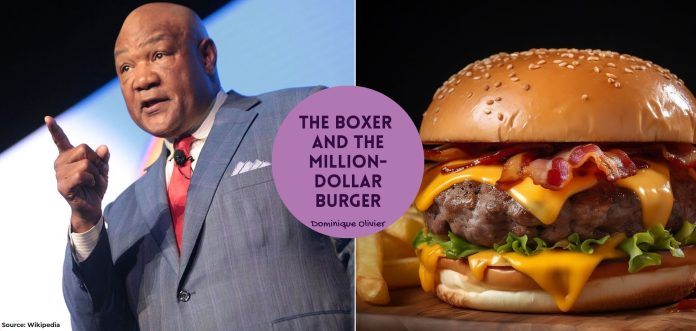What did George Foreman, the man who once flattened Joe Frazier in two rounds, know about small kitchen appliances? Apparently, quite a lot – at least when it came to selling them.
We live in the age of influence. According to recent estimates, the global influencer marketing industry is now worth over $21 billion, with brands pouring money into partnerships with TikTok stars, YouTubers, and Instagram personalities in the hopes that a single “Get ready with me” video or haul can drive a fortune in sales. These influencers have perfected the art of making a product feel personal, like they’re letting you in on a secret rather than selling you something.
But before the rise of #sponcon and algorithm-curated feeds, brands turned to a different kind of familiar face: the celebrity. Long before MrBeast moved merch or Hailey Bieber sold out lip gloss, it was athletes, actors, and musicians who helped bring products into living rooms. Michael Jordan had his Air Jordans. Cindy Crawford had Pepsi. And in one of the more unexpected twists of marketing history, George Foreman – former heavyweight boxing champion – became the face and name of a countertop grill.
The birth of the Fajita Express
The earliest version of the grill came from the mind of Michael Boehm, an inventor based in Batavia, Illinois. Boehm wanted to create a compact indoor grill that could cook food evenly on both sides, while draining excess fat away. Together with engineer Bob Johnson, Boehm built a prototype: a bright yellow grill with a floating hinge and a sloped cooking surface that let grease slide off into a separate tray.
It was called the Fajita Express, and it was as quirky as it sounds. The original design included risers to hold taco shells and catch fat from sizzling fajita meat. There were even dual trays – one for grease, and one to keep your tacos upright.
Despite showcasing it at various industry trade shows, the Fajita Express didn’t catch on. It was hard to explain, overly specific, and the taco angle didn’t resonate with buyers. It might have ended there if the prototype hadn’t landed in the offices of Salton, Inc. – which it fortunately did.
The Salton makeover
In the early 1990s, Salton was a mid-sized company with a catalogue full of kitchen products. Most were forgettable. But when they saw Boehm and Johnson’s prototype, they saw potential. Not in the taco angle, but in something broader: an easy-to-use electric grill that could sit on a kitchen counter, cook from both sides, and reduce fat while it worked.
Salton immediately got to work simplifying the product. They removed the taco-specific risers and dual trays. They adjusted the heating element, streamlined the shape, and made it feel less like a specialty item and more like a general-use countertop grill. They stripped away the overly niche fajita framing and positioned it as a solution for anyone who liked meat, convenience, and the illusion of healthy eating.
Now they just needed someone to sell it.
George Foreman enters the ring
The product, even with its improvements, still wasn’t turning heads at trade shows. It needed a hook. That came in the form of Sam Perlmutter, a veteran entertainment attorney and film producer, who had a knack for connecting ideas with star power. He was friends with Michael Srednick, a marketer who had spotted the original grill at a trade show and believed it had untapped potential. Together, they sent a sample to George Foreman.
Foreman was in the middle of a surprising career renaissance. After winning the heavyweight championship in his 40s – a feat nearly unheard of in boxing – he had begun a second life as a public figure and product endorser. He was big, charismatic, approachable, and importantly, he loved burgers. The grill made sense to him in a way that was both practical and personal: it let him indulge without guilt and cooked faster than the stove. He saw the appeal immediately.
A profit-sharing agreement was struck between Foreman and Salton. His name and face would be used to promote the product, and in return, he’d earn 40% of each sale. With that, the Lean Mean Fat-Reducing Grilling Machine was officially born.
From flop to feeding frenzy
The grill made its debut at the 1995 Gourmet Products Show in Las Vegas. Fresh off a close victory against Axel Schulz, Foreman was in full promotional mode. He even hosted a cocktail party for major retailers like Target and Macy’s, hoping to convince them to take a chance on the $39.99 appliance.
It worked – sort of. Retailers agreed to carry the grill, but when the holiday season came around, sales were disappointingly slow. By January, many stores wanted to return their unsold inventory. Salton was on the verge of shelving the entire thing.
But instead of giving up, the team made a critical change. First, they increased the surface area so the grill could cook four burgers instead of two. Then came the pivotal moment: George Foreman appeared live on QVC, an American home shopping channel, where he cooked and ate a burger on-air. In just three minutes, over 40,000 units were sold. For context, QVC averaged roughly 1,200 calls per minute at the time, so this was a landslide by comparison.
The message was clear. Viewers didn’t just want to cook; they wanted to cook like George Foreman.
“I’m so proud of it, I put my name on it”
By 1996, the grill had earned Salton $5 million in sales. That number exploded to $200 million by 1999, and more than $300 million by 2000. George Foreman, meanwhile, was cashing in on a scale few athletes ever reach outside their sport. He reportedly earned as much as $4 million per month in royalties at the peak of the grill’s popularity.
In 1999, Salton signed a new agreement to buy out the rights to Foreman’s name in perpetuity for $137 million, paid in five annual instalments of around $20 million, plus stock options. For context, Tiger Woods’ 1997 Nike deal got him $100 million. By the time all was said and done, it’s estimated Foreman made well over $200 million from putting his name on a grill – far more than he earned during his boxing career.
Copycats and cultural permanence
As the grill’s popularity grew, other companies tried to replicate its success. Evander Holyfield starred in infomercials for the Real Deal Grill. Olympic legend Carl Lewis endorsed the Health Grill. Even Jackie Chan was enlisted to market the Lean Mean Fat-Reducing Grilling Machine in Asia, where it was officially sold as the Jackie Chan Grill. But none of them made a dent in Foreman’s dominance.
Most kitchen gadgets come and go. Some, like the bread machine or the handheld smoothie blender, live fast and die young. But the Foreman Grill endured. To date, more than 100 million George Foreman Grills have been sold globally.
It wasn’t just the fat tray. It wasn’t just the slanted surface or the easy plug-in appeal. It was the timing, the branding, and the man himself. At a cultural moment when convenience was king and health consciousness was just beginning to creep into mainstream diets, the George Foreman Grill arrived with the perfect pitch: eat what you love, just with less fat.
Foreman himself made the product feel trustworthy. He wasn’t polished or scripted. He was friendly, slightly goofy, and impossible not to like. When he said, “It’s so good, I put my name on it,” it didn’t sound like a sales pitch – it sounded like a guy genuinely excited about a burger. Foreman made grilling feel fun, easy, and a little healthier. That simple combination turned a failing fajita idea into a household staple – and made George Foreman a fortune in the process.
He may have knocked out fighters in the ring, but his biggest victory came in kitchens.
Postscript: George Foreman passed away in March of this year, at the age of 76. While researching this article, I learned that he had 12 children – seven daughters and five sons. All five of his sons are named George. Now that puts a whole new spin on “I’m so proud of it, I put my name on it”, doesn’t it?
About the author: Dominique Olivier

Dominique Olivier is the founder of human.writer, where she uses her love of storytelling and ideation to help brands solve problems.
She is a weekly columnist in Ghost Mail and collaborates with The Finance Ghost on Ghost Mail Weekender, a Sunday publication designed to help you be more interesting. She now also writes a regular column for Daily Maverick.
Dominique can be reached on LinkedIn here.





Just wanted to say thank you for your beautiful and hilarious writing style. So refreshing from all the mass produced AI written blah blah blahs.
My Sundays are not complete until I receive the mail weekender.
Thank you Dominique. Thank you Ghost🙏.
It’s a great pleasure – and agreed, Dominique’s work is excellent and adds so much to this ecosystem!
Hi there Thabi, I’m so glad to hear that the Weekender makes your weekend better! You keep reading, and I’ll keep writing 😉